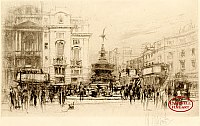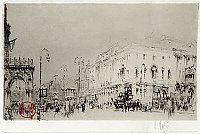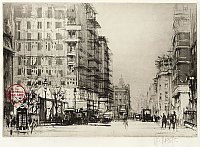 |
|||
William Walcot1874 – 1943 |
|||
|
Click on a picture for more details |
|||
|
|||
 |
|||
|
Born in Russia, William Walcot was trained and practised as an architect until his arrival in England, soon after the turn of the century. His brilliant sense of architectural perspective led to his rapidly becoming the foremost architectural artist of the period, enjoying spectacular success during his lifetime. William Walcot’s inventive style owed much to his early training as an architectural draughtsman in Paris, where he had developed a great sympathy for the work of the Impressionists. His superb architectural etchings were unique in their suggestion of space and in their grasp of scale – highly distinctive in style, these works combine architectural accuracy with an impressionistic appearance of vibrant everyday life. In recent years William Walcot’s work has enjoyed a huge surge in popularity which appears to be continuing unabated. [more] |
|||







